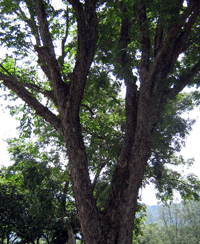
Akasia | Angsana | Asam Jawa | Jambu Laut | Jemerlang | Ketapang | Mambu | Mempari | Pukul Lima | Sentang

Introduction
Distribution Native to Southeast and East Asia and to the northern and southwest Pacific region; now distributed widely throughout the tropics.
Size Typically reaches 25–35 m (82–115 ft) in height with a broad canopy when grown in the open.
Habitat Grows at elevations of 1–1300 m (3.3– 4300 ft) with annual rainfall of 1300–4000 mm (50–160 in).
Vegetation Thrives best in riverine, closed, and secondary forests.
Soils Adapted to a range of soils, growing
best on deep, fertile, loamy, alluvial soils.
Growth rate In optimal conditions, height
growth may be 2 m/yr (6.6 ft/yr) for the first
3–4 years, slowing to about 1 m/yr (3.3 ft/yr)
thereafter.
Main agroforestry uses Soil stabilization, windbreaks, ornamental.
Main products Timber.
Yields Estimated at 5–10 m3/ha/yr (72–144ft3/ac/yr) over a 30–40 year rotation, on optimal sites.
Intercropping Planted as boundary and windbreak around food crops or as a living fence around pastures.
Invasive potential Has limited potential to invade undisturbed native plant communities.
Environmental Profile
The environmental profile of this species within its natural habitat is reported to be Vulnerable in the Philippines. Its status in Indonesia and parts of Malaysia is officially classified as either Extinct, Endangered, Vulnerable, or Rare, and it has been assigned a conservation category of Insufficiently Known in Vietnam which means that the species is suspected to be either Extinct, Endangered, Vulnerable, or Rare. The actual status of the species in Indonesia, Malaysia, and Vietnam is unknown because of inadequate information
